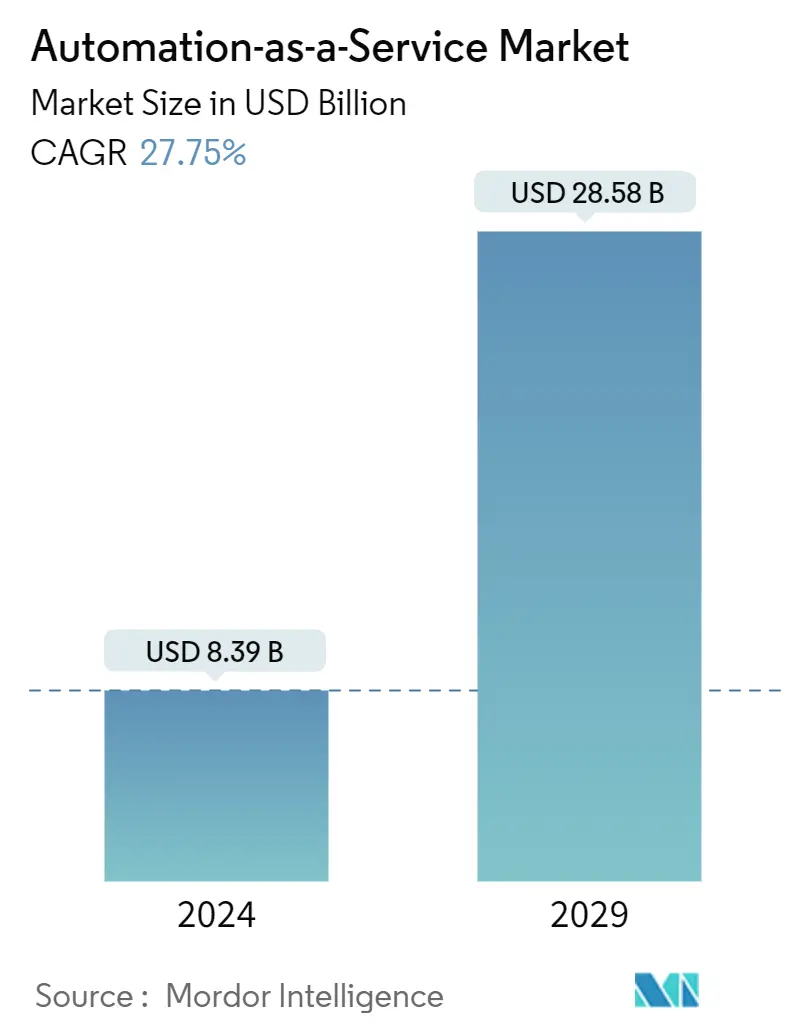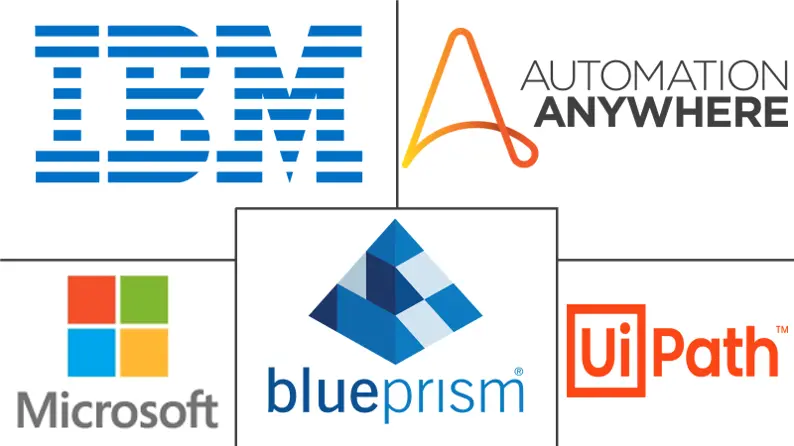Market Size of Automation-as-a-Service Industry

| Study Period | 2019 - 2029 |
| Market Size (2024) | USD 8.39 Billion |
| Market Size (2029) | USD 28.58 Billion |
| CAGR (2024 - 2029) | 27.75 % |
| Fastest Growing Market | Asia Pacific |
| Largest Market | North America |
Major Players
*Disclaimer: Major Players sorted in no particular order |
Need a report that reflects how COVID-19 has impacted this market and its growth?
Automation as a Service Market Analysis
The Automation-as-a-Service Market size is estimated at USD 8.39 billion in 2024, and is expected to reach USD 28.58 billion by 2029, growing at a CAGR of 27.75% during the forecast period (2024-2029).
Some key reasons propelling the growth of the studied market are the increasing acceptance of automation across all end-user sectors, expanding the reach of cloud computing, and rising IoT device numbers. The need for healthcare services is anticipated to increase in the upcoming years. Many operations, including admissions and patient histories, need to be automated as most countries' healthcare infrastructure develops to manage massive amounts of patient data.
- The rapid development of new technologies like artificial intelligence (AI), machine learning, cloud computing, and the Internet of Things (IoT), as well as their widespread use by businesses, have contributed to the significant expansion of automation as a service (AaaS). According to Morgan Stanley, the estimated USD 1 trillion in sales for the AI business by 2050 will directly impact the AaaS market. The adoption of cloud-based solutions will rapidly grow as firms look for deployment options that hasten value realization. Due to the growth of their digital workforces, businesses invest in private or public clouds to automate labor-intensive, challenging-to-automate processes.
- Business process automation focuses on automating routine IT procedures and business services to increase productivity, cut expenses, and maintain smooth operations. The general use of BPA throughout organizations results from several factors, including businesses preparing to move their infrastructure to the cloud, bolstering business continuity, and enhancing corporate processes. For instance, Generali, a significant insurance provider in Europe, went from manual to automated business operations, saving time and money. Through repeatable procedures, this led to savings of up to 90% and a 50% decrease in the time required to underwrite challenging tasks.
- Adopting cloud solutions will expand significantly shortly as companies demand deployment options that enable them to gain benefits more quickly. Companies invest in a private or public cloud because they require flexible deployment and licensing choices as they increase their digital workforces to automate tasks. Consequently, the majority of market players focus primarily on cloud-based solutions. Amperity, a brand-new company founded in 2022, offers an enterprise data platform to transform fragmented consumer data into revolutionary cloud experiences.
- Data security and privacy are factors that companies should focus on as data loss is possible. Data loss is a threat from new cases like AlienBot, Wannacry, Cryptojackling, Fireball, Zeus, and others if a ransom is not paid for the decryption key to restore the data. These threats include spam emails, removable drives, potentially unwanted software, and suspicious websites. Over 600 Windows processes are blocked by the most recent malware, called Clop. Therefore, many organizations now include security in their plans to save money, protect the data, and lower the risk of an attack.
- The global demand for automation was accelerated and reemphasized by the COVID-19 pandemic. Across industries, there was an increase in cloud-native bots, intelligent data capture, and process discovery bots. There was a significant desire for automation to streamline tasks and cut expenses, as seen by the high rises in utilization rates from 60 percent to 95 percent reported by automation software vendors.
